Intel‘s (INTC 2.17%) first-quarter results came up flat, and investors sent shares of the struggling semiconductor company lower. Intel shares are down more than 40% over the past year.
Revenue was flat for the quarter, coming in at $12.7 billion. Adjusted earnings per share (EPS) sank 28% to $0.13. The lackluster numbers easily surpassed the $0.01 in EPS and $12.3 billion in revenue in the analyst consensus compiled by LSEG, but Intel’s guidance disappointed.
Let’s take a closer look at Intel’s quarterly results to see when a turnaround could be in store.
Intel’s struggles continue
Intel’s flat revenue was the first time it didn’t see a revenue decline since Q1 of last year. However, the company has been more stuck in the mud in regard to revenue growth than seeing any big declines.
Intel’s product revenue fell 3% to $11.8 billion. Its client computing group (CCG) product revenue fell 8% to $7.6 billion, while data center and AI (DCAI) product revenue rose 8% to $4.1 billion. The company said it saw better-than-expected sales of its Xeon chip, which is a CPU (central processing unit) designed for data centers and enterprise services. However, it said the growth was likely driven by customers increasing orders ahead of tariffs.
Its foundry business, meanwhile, had revenue increase 7% to $4.7 billion. However, the segment continues to post large losses, with an operating loss of $2.3 billion in Q1. That was a slight improvement from its $2.4 billion loss a year ago.
Revenue from Intel’s other businesses, which include subsidiaries Altera and Mobileye, shot up 47% to $900 million. This segment also flipped from an operating loss of $170 million to a profit of $103 million.
| Segment | Revenue | Revenue Growth (YOY) |
|---|---|---|
| Product | $11.8 billion | (3%) |
| –CCG | $7.6 billion | (8%) |
| –DCAI | $4.1 billion | 8% |
| Foundry | $4.7 billion | 7% |
| Other (subsidiaries) | $900 million | 47% |
Data source: Intel. YOY = year over year.
Gross margins remain under pressure, falling by 410 basis points from 41% to 36.9%. Some of the gross-margin pressure stems from ramping up the foundry business, but Intel has also seen a lot of margin pressure in its CCG and DCAI businesses as well.
The company produced $813 million in operating cash flow during the quarter, while spending $5.2 billion in capital expenditures (capex) as it continues to pour money into its foundry business. It ended the quarter with $50.2 billion in debt against $21.1 billion in cash and short-term investments.
Looking ahead, it forecast Q2 revenue to range between $11.2 billion and $12.4 billion, well below analyst expectations for revenue of $12.8 billion. At the midpoint, that would be a year-over-year decline in revenue of about 8%.
Due to its struggles, Intel is looking to significantly cut its operating expenses (opex). It plans to reduce opex to $17 billion this year and $16 billion in 2026. Excluding restructuring charges, opex was $22 billion in 2024, or $19.4 billion when excluding share-based compensation.
Meanwhile, it reduced its capex budget by $2 billion to $18 billion, and it plans to monetize noncore assets. This will begin the process of improving its balance sheet.
Image source: Getty Images.
Is a turnaround near?
The simple answer to that question is no. None of this is a quick fix, and Intel won’t be able to just cut its way to prosperity. On that front, it plans to refine its artificial intelligence (AI) strategy with the goal of developing full-stack AI solutions that improve accuracy, power efficiency, and security. That’s a great goal to have, but Intel will have difficulty competing with a company like Nvidia, which is currently leaps and bounds ahead of it and has created a wide moat with the CUDA software platform.
That said, I think there’s value to be unlocked within Intel. Its core business, while not growing, has been fairly steady on the revenue front, and I would expect gross margins to eventually start to plateau. The company has a lot of physical assets, as it’s poured money into its foundry business, building new fabrication plants in both the U.S. and Europe. It has spent over $200 billion in capex over the past two years, which is more than twice its market cap.
As a result, Intel trades at a ratio of price to tangible book value (TBV) of just 1.2. TBV is the value of its physical assets minus any net debt, so basically, at current prices, investors are able to buy Intel at around the value of its assets.
INTC Price to Tangible Book Value data by YCharts.
Investors will need to be patient, but I think there’s enough value in Intel for its stock to eventually work. That means you might consider accumulating shares now, and on any further dips.
Geoffrey Seiler has no position in any of the stocks mentioned. The Motley Fool has positions in and recommends Intel and Nvidia. The Motley Fool recommends Mobileye Global and recommends the following options: short May 2025 $30 calls on Intel. The Motley Fool has a disclosure policy.



